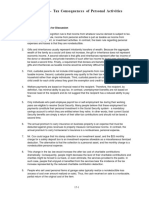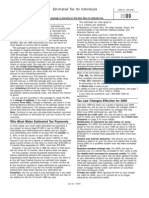Calculate Your Federal Taxes
Calculate Your Federal Taxes
Uploaded by
api-718873824Copyright:
Available Formats
Calculate Your Federal Taxes
Calculate Your Federal Taxes
Uploaded by
api-718873824Original Title
Copyright
Available Formats
Share this document
Did you find this document useful?
Is this content inappropriate?
Copyright:
Available Formats
Calculate Your Federal Taxes
Calculate Your Federal Taxes
Uploaded by
api-718873824Copyright:
Available Formats
NGPF Activity Bank
Taxes
CALCULATE: Your Federal Taxes
In this activity, you will use sample W-2 and 1099 forms as well as information about deductions and credits to calculate the taxes owed and
refund of each individual.
Part I: Scenarios
To illustrate how different circumstances affect your tax return, we’ll explore the case of four individuals. Assume all individuals are filing as single
and not claimed as a dependant:
Name Employment Info W-2 Form Deductions Credits
Ashley Roslin ● Worked around 10 ● Ashley made a $50 ● Ashley
hours/week at a local donation to an animal has no
Ashley’s W-2
coffee shop for $13/hour shelter credits
available
Melinda ● Worked around 20 ● As an independent ● Melinda
Flowers hours/week at a local contractor, Melinda has $350
ice cream shop Melinda’s W-2 was able to deduct in credits
● Worked irregularly as $645 in business
an independent Melinda’s 1099 related expenses and
contractor for a $925 for vehicle use
landscaping company
Elyse ● Worked as a bus driver ● Elyse paid $1,500 in ● Elyse has
McPherson making $32/hour plus state and local taxes $1,000 in
Elyse’s W-2
overtime pay and made $5,000 in credits
charitable contributions
Jameson ● Work as an ● Jameson paid $16,000 ● Jameson
Jameson’s
Michaels independent in mortgage interest, has $1,400
1099
contractor consulting $2,500 in charitable in credits
for a tech firm contributions
Part II: Taxable Income and Deductions
Before calculating taxes, you will sometimes be able to apply deductions, which reduce the amount of your total income that will
be taxed.
The deductions that will apply in this activity:
Personal Deductions
1) Take the standard deduction of $13,850 for single individuals in 2023. 90% of filers use this option.
2) Itemize deductions if the total deductions will be more than the standard deduction. This would include items like:
a) Interest on the first $750,000 of a mortgage
b) State and local taxes up to $10,000
c) Charitable contributions
Business Deductions
3) If you receive a 1099 for work as an independent contractor, you can deduct business expenses on top of your personal
deductions
Example
You made $30,000 last year as an independent contractor and are able to apply deductions of $10,000 in personal expenses and
www.ngpf.org Last updated: 1/4/24
1
$3,200 in business expenses. For personal expenses, it’s better to take the standard deduction of $13,850. You will calculate your
taxes owed on $30,000 - $13,850 - $3,200 = $12,950 of taxable income.
1. Consider each individual’s situation, then complete the table below by listing the income reported on all W-2/1099
forms in column (a), total deductions in column (b) and their taxable income after deductions in column (c).
Name Gross Income on W-2/1099 Total Deductions Taxable Income after
(a) (b) Deductions
(c)
Ashley $6,240 $50 $6,190
Melinda $21,151 $1,570 $19,581
Elyse $34,220 $6,500 $27,720
Jameson $66,500 $16,000 $48,000
Part III: Federal Income Taxes Owed
US Federal Income Taxes are a progressive tax system, which means that different portions of your income are taxed at different
rates. Here are the 2023 tax brackets for single individuals:
Example
If your taxable income is $57,500 after all deductions, we would calculate federal income taxes owed like this:
Tax Bracket Taxable Income Remaining Taxes Owed
10% Total income remaining: $57,500 The first $11,000 is taxed at 10%:
Bracket $11,000 * .10 = $1,100 taxes owed
12% Bracket Total Income remaining: $57,500 - $11,000 = This bracket covers the next $33,725 in taxable income.
$46,500
You can find this by subtracting the top of this bracket from the
top of the previous bracket:
$44,725 - $11,000 = $33,725
$33,725 * .12 = $4,047 taxes owed
22% Total income remaining = $46,500 - $33,725 This bracket covers the next $50,650 in taxable income but we
Bracket = $12,775 only have $12,775 left:
$12,775 * .22 = $2,810.50 taxes owed
Summary calculation
Total taxes owed = $1,100 + $4,047 + $2,810.50 = $7,957.50 total federal income taxes owed
www.ngpf.org Last updated: 1/4/24
2
2. Now it’s your turn! Calculate the total taxes owed for each individual.
a. First, transfer the Taxable Income after Deductions column (c) from part II into column (c) below.
b. Next, calculate the amount owed for each bracket interval up to the individuals’ highest tax rate.
c. Finally, add these values together to find their overall taxes owed.
Name Taxable Income 10% Bracket 12% Bracket 22% Bracket Total Taxes Owed
after Deductions (d) (e) (f) (g)
(c)
Ashley $6,190 619 $619
Melinda $19,581 11,000 (1,100) 8581 (1,029.72) $2,129.72
Elyse $27,720 1,100 16,720 (2,006.40) $3,106.40
Jameson $48,000 1,100 33,725 (4,047) 3,375 (720.50) $5,867,50
Part IV: Credits
Credits are a reduction in your Total Taxes Owed AFTER your taxes are calculated. There are a lot of different credits for things
like child care, education, health care, and adoption.
There are some credits that are refundable, which means that you will be paid if they cause a refund in total taxes owed.
However, most credits are non-refundable, which means that they will reduce your total taxable income to $0 but will not give
you a refund.
All of the credits in this activity are non-refundable credits.
Example
You calculated that you owe $4700 in taxes and have a $500 tax credit. Your new taxes owed after credits would be $4,700 - $500
= $4,200 in taxes owed after credits.
3. Transfer the Total taxes owed column (g) from part III into column (g) below. The amount of each individual’s total
credits is listed in Part I and can be brought down to column (h) below. Use this information to complete column (i)
of the table.
Name Total Taxes Owed Total Eligible Credits Taxes Owed after Credits
(g) (h) (i)
Ashley $619 $0 $619
Melinda $2,129.72 $350 $1,779.72
Elyse $3,106.40 $1,000 $2,106.4
Jameson $5,867,50 $1,400 $4,467.5
Part V: Summary
To wrap things up, let’s calculate and compare each individual’s marginal and effective tax rate. We will also check to see if each
individual will owe money in taxes or receive a refund.
● Your marginal tax rate is the highest tax bracket in which you owe taxes.
● If you divide your taxes owed after all deductions and credits by your total taxable income after deductions, then
multiply by 100, you will calculate your effective tax rate.
Example
Total income: $70,050.00
Total taxable income after deductions: $57,500.00
Total taxes owed: $8,387.60 total federal taxes owed
● Your marginal tax rate is 22% because that is the highest tax bracket that your money is taxed in
www.ngpf.org Last updated: 1/4/24
3
● Your effective tax rate will be
You can calculate whether you will get a refund or owe additional taxes by subtracting your total taxes owed and the amount that
is already withheld on your W-2 or 1099.
Example
You owe $8,367.60 and you had $9,250.60 federal income tax withheld from your paycheck on box 2 of your W-2.
$8,367.60 - $9,250.60 = -$883.00. Because you paid more than you owed, you will receive an $883 refund!
4. Transfer column (i) from Part IV above into column (i) below. Use the above example to complete the table below
to summarize each individual’s taxes.
Name Taxes Owed after Federal Taxes Withheld Refund/ Owed
Credits on W-2/1099 Taxes
(i) (l) (m)
Ashley $619 $196.25 $422.74 owed
Melinda $1,779.72 $534.96 $1,244.76 owed
Elyse $2,106.4 $3,947.30 -$1,840.9 refund
Jameson $4,467.5 $0 $4,467.5 owed
www.ngpf.org Last updated: 1/4/24
4
You might also like
- CALCULATE - Completing A 1040Document3 pagesCALCULATE - Completing A 1040Giselle Ubieta Salas45% (11)
- Valuation of Securities 1 - TBPDocument2 pagesValuation of Securities 1 - TBPShaina Monique RangasanNo ratings yet
- Bus Math-Module 5.4 Gross and Net EarningDocument51 pagesBus Math-Module 5.4 Gross and Net Earningaibee patatagNo ratings yet
- Solved Minden Corporation Wants To Open A Branch Operation in EasternDocument1 pageSolved Minden Corporation Wants To Open A Branch Operation in EasternAnbu jaromiaNo ratings yet
- Accuracy Checking - US TaxationTestDocument10 pagesAccuracy Checking - US TaxationTestAmit ManyalNo ratings yet
- ACC 430 Chapter 17Document13 pagesACC 430 Chapter 17vikkiNo ratings yet
- Chapter 06 - SamplesDocument3 pagesChapter 06 - SamplesJessica ZhangNo ratings yet
- 02 F6 LRP Questions FA2009 PDFDocument44 pages02 F6 LRP Questions FA2009 PDFJino JoseNo ratings yet
- 19 Best Real Estate Email TemplatesDocument21 pages19 Best Real Estate Email TemplatesBarry kevin mitchell50% (2)
- Calculate Your Federal TaxesDocument6 pagesCalculate Your Federal Taxesapi-719544021No ratings yet
- Solved Ms Reid Borrowed 50 000 From A Broker To Purchase LeroDocument1 pageSolved Ms Reid Borrowed 50 000 From A Broker To Purchase LeroAnbu jaromiaNo ratings yet
- Kap1 6th Ch01 Excel Tues Pm SolutionsDocument7 pagesKap1 6th Ch01 Excel Tues Pm Solutionstandelrajat71No ratings yet
- Introduction To Accounting EXE 1Document6 pagesIntroduction To Accounting EXE 1ntxthuy04No ratings yet
- Solved in January Ms NW Projects That Her Employer Will WithholdDocument1 pageSolved in January Ms NW Projects That Her Employer Will WithholdAnbu jaromiaNo ratings yet
- PA Lecture 7Document15 pagesPA Lecture 7jackparker01321No ratings yet
- Acc Chapter 2Document4 pagesAcc Chapter 2WissalNo ratings yet
- TaxreturnprojectDocument6 pagesTaxreturnprojectapi-312756385No ratings yet
- Basic Accounting IDocument24 pagesBasic Accounting IAlpha HoNo ratings yet
- KW Macro CH 07 End of Chapter ProblemsDocument10 pagesKW Macro CH 07 End of Chapter ProblemsAnirvan SenNo ratings yet
- Chapter 17 PDFDocument17 pagesChapter 17 PDFJay BrockNo ratings yet
- Afif Juwandira-1162003016-Jawaban UTS Semester GenapDocument10 pagesAfif Juwandira-1162003016-Jawaban UTS Semester GenapYusuf AssegafNo ratings yet
- CH 5 Problem Session Exercise - StudentDocument5 pagesCH 5 Problem Session Exercise - StudenthannahNo ratings yet
- South-Western Federal Taxation 2016 Individual Income Taxes 39th Edition Hoffman Solutions Manual 1Document26 pagesSouth-Western Federal Taxation 2016 Individual Income Taxes 39th Edition Hoffman Solutions Manual 1alisha100% (63)
- Case Study 1Document5 pagesCase Study 18142301001No ratings yet
- Paying Zero TaxesDocument23 pagesPaying Zero TaxesHappyGhostNo ratings yet
- Solved Simon Is Single and A Stockbroker For A Large InvestmentDocument1 pageSolved Simon Is Single and A Stockbroker For A Large InvestmentAnbu jaromiaNo ratings yet
- Jane Kent Is A Licensed Cpa During The First Month PDFDocument1 pageJane Kent Is A Licensed Cpa During The First Month PDFAnbu jaromia0% (1)
- University of Cambridge International Examinations General Certificate of Education Advanced Subsidiary Level and Advanced LevelDocument12 pagesUniversity of Cambridge International Examinations General Certificate of Education Advanced Subsidiary Level and Advanced LevelbernadilibraryNo ratings yet
- Solved MR and Mrs PJ Celebrated The Birth of Their ThirdDocument1 pageSolved MR and Mrs PJ Celebrated The Birth of Their ThirdAnbu jaromiaNo ratings yet
- Accrual Accounting ConceptsDocument11 pagesAccrual Accounting ConceptsRakesh KumarNo ratings yet
- Irrecoverable DebtsDocument21 pagesIrrecoverable DebtsjsxlinaNo ratings yet
- M4 Transaction Analysis JEDocument7 pagesM4 Transaction Analysis JEJohn Benedict Capiral TehNo ratings yet
- Your Business Financial Strategy 2 1 Financial Statements Business Growth DDocument5 pagesYour Business Financial Strategy 2 1 Financial Statements Business Growth Dtariq khanNo ratings yet
- Calculating National IncomeDocument4 pagesCalculating National IncomeKhamica ArcherNo ratings yet
- Ch05 Ans Sep28 1 - GJFFJ - CHAPTER 5 The Expanded Ledger Revenue, Expenses, and Drawings SECTION 5 - StudocuDocument1 pageCh05 Ans Sep28 1 - GJFFJ - CHAPTER 5 The Expanded Ledger Revenue, Expenses, and Drawings SECTION 5 - StudocumilanschalinNo ratings yet
- Income Must Be Money or Convertible Into Money Nature of Trade)Document6 pagesIncome Must Be Money or Convertible Into Money Nature of Trade)HD DNo ratings yet
- US Internal Revenue Service: F1040es - 2000Document7 pagesUS Internal Revenue Service: F1040es - 2000IRSNo ratings yet
- Eshetu Gelagay Ind Ass Acc - For ManagersDocument12 pagesEshetu Gelagay Ind Ass Acc - For ManagersabiyNo ratings yet
- Level 01 - Chapter 5Document31 pagesLevel 01 - Chapter 5Humberto MSNo ratings yet
- Fundamentals of Accounting IiDocument39 pagesFundamentals of Accounting IiMintayto TebekaNo ratings yet
- Financial Stateme NT AnalysisDocument21 pagesFinancial Stateme NT Analysisalexanderquevedo04No ratings yet
- Cash Flow Calculator CFO SelectionsDocument12 pagesCash Flow Calculator CFO Selections202040336No ratings yet
- Eia1001 - Discussion 3 - Equation and TransactionsDocument4 pagesEia1001 - Discussion 3 - Equation and TransactionsMUHAMMAD ZAIM ILYASA KASIMNo ratings yet
- Chap002 RWJDocument50 pagesChap002 RWJmohamed ashorNo ratings yet
- Tax Return Project Situation - Cohen Tax Year 2015 - Fall 2016Document5 pagesTax Return Project Situation - Cohen Tax Year 2015 - Fall 2016Shivani Jani0% (3)
- Solved Refer To The Preceding Problem and Assume That Mrs NunnDocument1 pageSolved Refer To The Preceding Problem and Assume That Mrs NunnAnbu jaromiaNo ratings yet
- Caution - Guidance For Use of The 2009 Form 1040-ES, Estimated Tax For IndividualsDocument8 pagesCaution - Guidance For Use of The 2009 Form 1040-ES, Estimated Tax For Individualsezra242No ratings yet
- Tugas Responsi (Individu) AKT - Keuangan Ramelinium Purba (190120144)Document6 pagesTugas Responsi (Individu) AKT - Keuangan Ramelinium Purba (190120144)Ramelinium PurbaNo ratings yet
- Bankruptcy Problems MirzaDocument3 pagesBankruptcy Problems MirzaKesarapu Venkata ApparaoNo ratings yet
- Chapter 4 Question ReviewDocument11 pagesChapter 4 Question ReviewUyenNo ratings yet
- (Team 1) Case Study Joan HoltzDocument5 pages(Team 1) Case Study Joan HoltzAlyssa San FelipeNo ratings yet
- Outline For Hong Kong Taxation Presentation Question Q15Document5 pagesOutline For Hong Kong Taxation Presentation Question Q15Parco LeeNo ratings yet
- Beams10e Ch07 Intercompany Profit Transactions BondsDocument25 pagesBeams10e Ch07 Intercompany Profit Transactions BondsIrma RismayantiNo ratings yet
- Received Without Restriction As To Use or Disposition) Must Be Reported (In Year 1) ForDocument21 pagesReceived Without Restriction As To Use or Disposition) Must Be Reported (In Year 1) ForjsanohNo ratings yet
- Rules of Debit and CreditDONEDocument22 pagesRules of Debit and CreditDONEayaa caranzaNo ratings yet
- Solved Marcy Tucker Received The Following Items This Year Determine ToDocument1 pageSolved Marcy Tucker Received The Following Items This Year Determine ToAnbu jaromiaNo ratings yet
- Final AdjustingjyjDocument36 pagesFinal AdjustingjyjAlayka Ann Pirante50% (2)
- Measurement - ReceivablesDocument38 pagesMeasurement - Receivablesakash.rajanstl02No ratings yet
- Build A Successful Retirement Plan Using Real Estate: A Step-By-Step Path To Early RetirementFrom EverandBuild A Successful Retirement Plan Using Real Estate: A Step-By-Step Path To Early RetirementNo ratings yet
- Mr. Nayan's Case Is Under MicroscopeDocument23 pagesMr. Nayan's Case Is Under MicroscopeSandip Kumar JanaNo ratings yet
- Synopsis Report: The Study of Risk Management in Banking SectorDocument7 pagesSynopsis Report: The Study of Risk Management in Banking SectorAadriti Upadhyay100% (2)
- Factors Affecting Employee Motivation in Case of Wachemo University College of Business and EconomicsDocument24 pagesFactors Affecting Employee Motivation in Case of Wachemo University College of Business and Economicsmulugetakassa523No ratings yet
- Vgbe S 821 91 2021 12 en - Ebook A4 ShopDocument76 pagesVgbe S 821 91 2021 12 en - Ebook A4 ShopPietroNo ratings yet
- CRI - 2014 - LFS - Q - Variables NamesDocument19 pagesCRI - 2014 - LFS - Q - Variables Namessavan anvekarNo ratings yet
- Academic Program 2018: Business AdministratrionDocument13 pagesAcademic Program 2018: Business AdministratrionĐặng Thảo Vân AnhNo ratings yet
- Startup Support in GujaratDocument21 pagesStartup Support in GujaratVipul PatelNo ratings yet
- Ig CommerceDocument159 pagesIg CommerceRouful RasoolNo ratings yet
- ICP Invoice - ICP 451883Document2 pagesICP Invoice - ICP 451883Sam RajaNo ratings yet
- Course Outline ECON2236 - 2021Document4 pagesCourse Outline ECON2236 - 2021Jana INo ratings yet
- Entrepreneurship Lecture Notes Part 1Document9 pagesEntrepreneurship Lecture Notes Part 1Peter100% (1)
- Fiat Lux Academe: CaviteDocument6 pagesFiat Lux Academe: CaviteIvan PimentelNo ratings yet
- FABM 2 Module 9 Income Tax DueDocument11 pagesFABM 2 Module 9 Income Tax DueJOHN PAUL LAGAO100% (2)
- Legal TrusteeDocument1 pageLegal TrusteeOwais MalikNo ratings yet
- Mutual Funds (Icici)Document1 pageMutual Funds (Icici)Adil KhanNo ratings yet
- Personal Taxation QuestionDocument2 pagesPersonal Taxation QuestionNORZAFIRAH BINTI YUSAININo ratings yet
- Financial StatementsDocument7 pagesFinancial StatementsLorgie Khim IslaNo ratings yet
- Extent of Artificial Intelligence Into Accounting and Auditing Work - An Analytical Attempt of Job and DutiesDocument13 pagesExtent of Artificial Intelligence Into Accounting and Auditing Work - An Analytical Attempt of Job and DutiesJUNIOR SARANGONo ratings yet
- Mauryan Economy: ST ND RD THDocument4 pagesMauryan Economy: ST ND RD THRamita Udayashankar100% (4)
- Modern Enterprise Architecture Using DevSecOpsDocument204 pagesModern Enterprise Architecture Using DevSecOpsdpellicer100% (3)
- Hindustan Motors Case StudyDocument4 pagesHindustan Motors Case StudyAsif. MahamudNo ratings yet
- Adoption AgreementDocument51 pagesAdoption Agreementspades24kNo ratings yet
- pp0nqxt2kp8b-5HR03 Brief 24 062Document7 pagespp0nqxt2kp8b-5HR03 Brief 24 062Kibet ElishaNo ratings yet
- Attachment Tutor 9Document6 pagesAttachment Tutor 9Florielyn Asto ManingasNo ratings yet
- Group 13 Entrepreneur Report Das Abdul GlobalDocument25 pagesGroup 13 Entrepreneur Report Das Abdul GlobaldanialdurraniNo ratings yet
- Verizon - UsaDocument3 pagesVerizon - UsaKenneth GonzalesNo ratings yet
- Covestro Annual Report 2021Document313 pagesCovestro Annual Report 2021Tobias JankeNo ratings yet
- Forain Filter To PLTUDocument1 pageForain Filter To PLTUposmarichardNo ratings yet

























































































